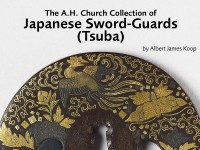The A. H. Church Collection of Japanese Sword-Guards (Tsuba)
An unpublished catalogue of the A. H. Church collection of Japanese sword-guards (tsuba) by Albert James Koop.

Publications online: 1264 objects
Tsuba with wave pattern
-
Literature notes
Aoi shape (or rather mokkō with each lobe slightly pointed); four large openings, outwardly of double-ogee profile, surround the seppadai crosswise; polished surface, each face covered with two rows of irregular [wave pattern, see Fig. 7] pattern in brass wire inlay, the outer row slightly overruning the edge. -
Details
- Associated place
- Date
- 17th century (1601 - 1700)
- Material and technique
- iron, with cut and filed openwork decoration, polished surface (migaki-ji), and hira-zōgan (flat inlay) in brass wire
- Dimensions
- 8.4 x 8.2 x 0.4 cm (height x width x depth)
- Material index
-
processed material › metal › iron,processed material › metal › alloy › copper alloy › brass
- Technique index
-
cut,
- Object type index
-
arms/armour › koshirae › kodogu › tsuba
- No. of items
- 1
- Credit line
- Bequeathed by Sir Arthur H. Church, 1915.
- Accession no.
- EAX.10140
-
Further reading
Koop, Albert James, The A. H. Church Collection of Japanese Sword-Guards (Tsuba), 3 vols (Oxford, Ashmolean Museum, 1929), no. 140
Glossary
tsuba
-
tsuba
Japanese sword guard.
Location
-
- currently in research collection
Objects are sometimes moved to a different location. Our object location data is usually updated on a monthly basis. Contact the Jameel Study Centre if you are planning to visit the museum to see a particular object on display, or would like to arrange an appointment to see an object in our reserve collections.
Publications online
-

The A. H. Church Collection of Japanese Sword-Guards (Tsuba)
Aoi shape (or rather mokkō with each lobe slightly pointed); four large openings, outwardly of double-ogee profile, surround the seppadai crosswise; polished surface, each face covered with two rows of irregular [wave pattern, see Fig. 7] pattern in brass wire inlay, the outer row slightly overruning the edge.
Notice
Object information may not accurately reflect the actual contents of the original publication, since our online objects contain current information held in our collections database. Click on 'buy this publication' to purchase printed versions of our online publications, where available, or contact the Jameel Study Centre to arrange access to books on our collections that are now out of print.
© 2013 University of Oxford - Ashmolean Museum

